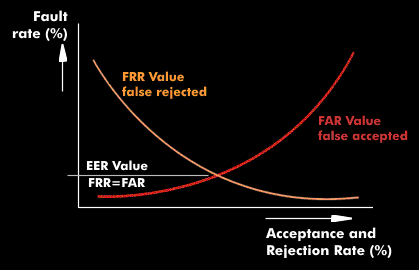false rejection rate (FRR)
The False Rejection Rate(FRR) is a value that describes the denial of access to a system even though access authorization has been granted. This value is of interest in biometric systems because they often interpret biometric data incorrectly.
It is the case that the biometric data of a person whose data is available as reference data is not recognized, although it is the correct person.
The FRR value is calculated as the ratio of the number of false rejections( NFR) to the number of legitimate attempts (NEA), expressed as a percentage. A high FRR value indicates that the biometric identification is good. This contrasts with the False Acceptance Rate( FAR), which has a low value when identification is high. While the Fahler rate of False Rejection Rate (FRR) falls as the percentage of rejection and acceptance rate increases, the False Acceptance Rate (FAR) increases. For the Equal Error Rate (ERR), both error rates are equal: FRR = FAR.

